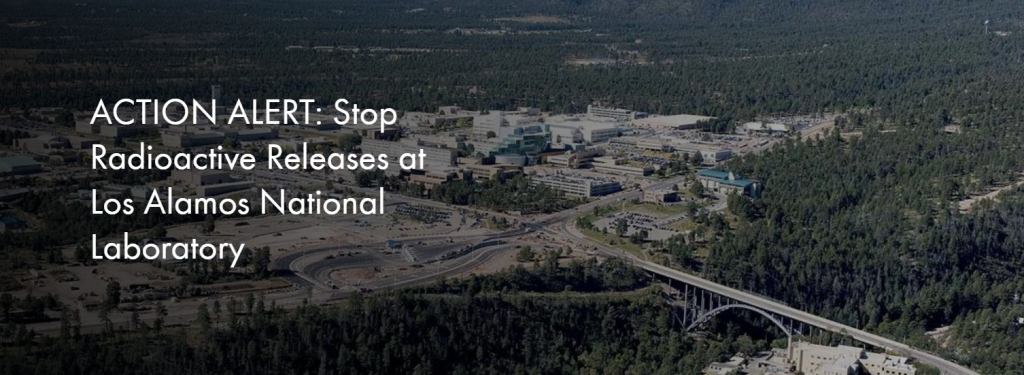
Because of overwhelming public demand and technical problems with the first virtual public meeting, the National Nuclear Security Administration is holding a second meeting on the Los Alamos National Laboratory’s (LANL’s) controversial plan to vent up to 100,000 curies of tritium gas. Tritium is a radioactive isotope of hydrogen, used to boost the explosive power of nuclear weapons. Most vented tritium will condense into water vapor which can then be readily ingested by living organisms, including humans. Fetuses are particularly at risk.
LANL’s nuclear weapons budget has doubled over the last decade to $2.9 billion in fiscal year 2021. But funding for so-called cleanup has remained flat at around $220 million, or 8% that of nuclear weapons. In fact, LANL plans to “cap and cover” some 200,000 cubic yards of radioactive and toxic wastes, leaving them permanently buried in unlined pits above our groundwater, some three miles uphill from the Rio Grande, and call it cleaned up. To add to this, the Lab now plans to dose the public by venting excess tritium.
The Flanged Waste Tritium Containers (FTWCs) were packaged at LANL’s Weapons Engineering Tritium Facility in 2007 and sent to the Area G waste dump for permanent disposal. However, during an audit of the containers officials identified lead in the materials inside the FTWCs, resulting in the containers being designated as hazardous waste requiring offsite disposal. Further analysis identified the “potential” for a flammable, pressurized mixture of hydrogen and oxygen in the headspace of the FTWCs, requiring venting to enable personnel to safely move the containers.
LANL’s side of the story is available on this page, including a copy of its Flanged Tritium Waste Containers Venting Presentation (PDF).
Some questions that we believe the Lab needs to answer are:
1) Why is it urgent to vent the FTWCs now? What is their explosive potential? What are the risks should an explosion occur? Why would the potential public health risks of venting tritium outweigh the risks of not venting?
2) Has the Lab prepared a rigorous analysis of alternatives to open venting of tritium? Or is it simply pursuing the cheapest way to get rid of excess tritium?
3) LANL is required to obtain a “temporary authorization” from the New Mexico Environment (NMED) to proceed with its tritium venting. Has the Lab given NMED a rigorous analysis of alternatives to open venting of tritium? If not, why should NMED grant the temporary authorization?
4) Tritium has a half-life of 12.3 years. Why not just let the tritium decay away to reduce the public health risk?
5) The Lab claims that tritium will be captured during venting. What solid documentation is there of that, and at what percentage, instead of general, unsubstantiated statements?
6) The Lab asserts that the tritium releases will be carefully monitored. How can the public trust LANL given its past history of serious noncompliance with the Clean Air Act’s requirements for monitoring radioactive air emissions?
Potential Health Effects of Tritium
The available literature on the potential health effects of tritium varies widely in their conclusions, sometimes in contradictory fashion. Not surprisingly the nuclear energy and weapons industries pretty much dismiss any serious public health impacts from tritium. In contrast, some independent scientists have warned that radioactive tritium can remain in the ova of female human fetuses after birth for life.
Read “Selected Literature on the Potential Health Effects of Tritium”
How to Access the Public Information Session
*Please indicate your intentions to speak when registering.
The public information session will be hosted via WebEx Events, a different platform than the first session in an effort to accommodate the overwhelming public interest in this matter. People who wish to attend can register here. The WebEx Event meeting password is vG9Rbr3m3f4. Those who do not have internet access may call in by phone at 415-655-0001, access code 173 622 0434. If joining by phone, the meeting password is 84972736.*- If you wish to speak at the information session, please indicate your desire to do so with your registration.
Those wishing to submit questions in advance of the presentation may send them to [email protected].
Attendees should join the webinar 15 minutes early. This will allow time to install or download any needed software or applications and confirm that attendees are able to connect to both audio and video. All required software is free of charge to all participants. While WebEx software is intended to run on all commercial internet browsers (such as Internet Explorer and Safari), WebEx recommends using Chrome or Firefox internet browsers for the best experience. Tips for WebEx Events use can be found here.
Go to www.nukewatch.org for more information.
